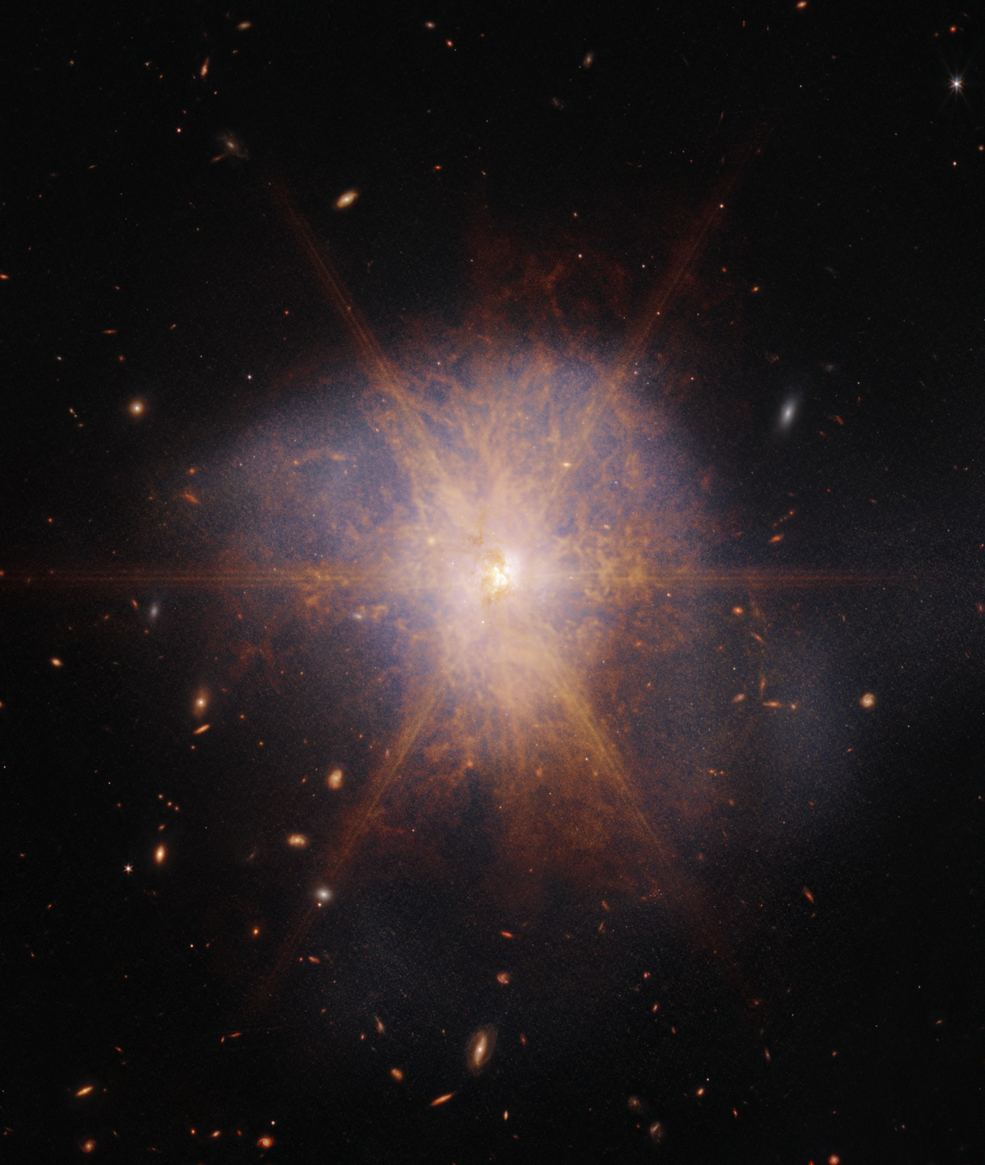If we want to know what it’ll look like in about 4.5 billion years when our galaxy merges with Andromeda, we might take a look at ARP 220. ARP 220 is a pair of galaxies that are in the process of merging. The merging galaxies emit brilliant infrared light, and the James Webb Space Telescope captured that light in a vivid portrait.
ARP 220 is an Ultraluminous Infrared Galaxy (ULIRG), and it’s the closest one to Earth. This makes it a natural laboratory for studying galaxy mergers, and it also means that the JWST, with its powerful infrared capabilities, is ideally suited to studying it.
A lot can happen when galaxies merge, and it’s an extremely active area of research. The outcome depends on speed, angles, and the masses and compositions of the galaxies. The friction between gas and dust is a driving factor in some of the outcomes of mergers, like star birth.
ARP 220‘s collision triggered a massive episode of star birth, and the combined light is equal to one trillion Suns. That number humbles our own galaxy, which is as bright as about one billion Suns. Each of the galactic cores in ARP 220 is encircled by a rotating, star-forming ring, and these rings are the source of all this infrared energy. The light from all that starburst creates a prominent, spiked feature that dominates the image.

ARP 220 started colliding about 700 million years ago. For reference, Earth was in its Cryogenian Period at that time and may have been experiencing one of its hypothesized Snowball Earth episodes. ARP 220’s merger triggered an epic round of star formation. It created about 200 massive star clusters in the central region, packing them into an area about 5,000 light-years across, which is about 5% the size of the Milky Way. Researchers think that the amount of gas in this central, combined region is equal to the entire amount of gas in the Milky Way, a testament to the staggering power of galaxy mergers.
Dust blocks much of the light from ARP 220, as images from other telescopes show. In the Hubble image below, much of the detail that the more powerful JWST reveals is obscured.

ALMA has also imaged ARP 220 in radio emissions. A composite image from 2016 combining ALMA and Hubble images clearly shows the pair of cores. Thanks to ALMA, the cores are so bright that they dominate the image.

In 2017, a team of astronomers published a paper based on ALMA images of the pair of galactic cores. Detailed study showed that both cores are rotating, which the JWST image helps confirm. The paper also showed that the cores in ARP 220 each have a nuclear disk of concentrated gas that’s sinking rapidly into the centers. According to the authors of this paper, the western nucleus has a dust column so dense that it’s equal to a wall of gold 30 centimetres (1′) thick.

ARP 220 is an extreme astrophysical environment, and comparisons with the Milky Way illustrate that. Our galaxy has dense gas structures near its nucleus, and the giant molecular cloud Sgr B2 is one of the most massive. It’s about 390 light-years from the center of the Milky Way and is about 150 light-years across. It contains about 3 million solar masses. Though that sounds impressive, it means that only a small area of the Milky Way’s nucleus is covered by dense gas, while ARP 220 is dominated by dense gas.
ARP also contains about 100 supernova remnants. These remnants are contained in a region less than 500 light-years across. In a 2017 paper that studied both supernovae (SNe) and supernova remnants (SNr), the authors found that ARP 220 had a total SN rate of 4 yr-1. (According to Wolfram Alpha, that’s about one every three months.) Compare that to the Milky Way’s much lower rate of supernovae which is about one every 50 years. In fact, in 2011, astronomers identified seven supernovae at the same time in ARP 220 that all exploded in the previous 60 years.
ARP 220 is nearer to the end of its merger than its beginning. The gas kinematics are calming down, and while it’s still an intense astrophysical environment, it won’t stay that way. Eventually, it’ll have only one nucleus.
There are two X-ray sources in ARP 220, one at the center of one of the pre-merger galaxies and another one near it. These are probably supermassive black holes (SMBHs) that resided at the center of each galaxy. Astronomers struggle to see clearly into the central region, but a 2017 paper said that the SMBHs are relatively modest in mass, only about 10 thousand solar masses each. That’s at the low end of the scale for SMBHs.
Whatever their size, in a few hundred million years, give or take, this likely pair of SMBHs will probably merge into an even more massive SMBH at the center of the new, unified galaxy, creating a gravitational wave in the process.
More:
- Press Release: Webb Captures the Spectacular Galactic Merger Arp 220
- Research: ALMA Resolves the Nuclear Disks of Arp 220
- Universe Today: Webb and Hubble Peer Into the Wreckage of a Galactic Collision

